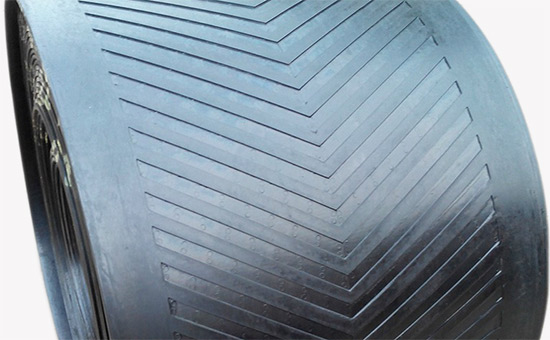
Processing waste rubber products into rubber powder and then recycling them into the production of rubber products can not only save rubber resources, but also reduce environmental pollution, and appropriate amounts of rubber powder can be added in the production of various tapes. In actual production, rubber powder 2YLYY715 can be divided into superfine rubber powder, fine rubber powder, fine rubber powder, coarse rubber powder, etc. according to the fineness, and can be divided into vulcanized rubber powder and activated rubber powder according to surface activity. Different types of rubber powder have different characteristics and can be used in the production of different types of tape.
1. Rubber conveyor belt
Rubber conveyor belts are mainly used for the transportation of various solid materials, covering various fields such as mines, steel, coal, building materials, chemicals, and food. Conveyor belts mainly include cover rubber, buffer rubber, cloth layer wipe rubber, cloth layer glue, and the cover rubber has higher requirements on the tensile strength, abrasion resistance, aging resistance, and tear resistance of the rubber material. It can be mixed Use appropriate amount of fine rubber powder or activated rubber powder to reduce the cost of rubber conveyor belts and improve the performance of rubber materials.
For example: when natural rubber/butadiene rubber is produced with a 50/50 ratio of ordinary fabric core conveyor belts, natural rubber, styrene butadiene rubber and fine rubber powder can be used instead, and the ratio of natural rubber/styrene butadiene rubber/fine rubber powder can be controlled. Around 20/50/30. Activated rubber powder can also be added when natural rubber/butadiene rubber is used to prepare conveyor belt cover rubber at a ratio of 70/30. The addition ratio of natural rubber/butadiene rubber/rubber powder is generally controlled at about 40/30/30, which can be based on actual conditions. Need to increase or decrease the amount of activated rubber powder appropriately.
2. Rubber transmission belt
In actual production, rubber transmission belts are generally processed with synthetic rubber as the main raw material and a proper amount of natural rubber. When using styrene-butadiene rubber/natural rubber to produce rubber transmission belts, adding rubber powder in an appropriate amount can improve the processing performance of the rubber material, the accelerator rubber material and the compounding agent are uniformly mixed, and the calendering process conditions are improved. When styrene butadiene rubber/natural rubber is used together in a ratio of 80/20, under the premise that the total amount of raw rubber is 100 parts, about 30-40 parts of activated rubber powder can be added to improve the process and reduce the cost.
Compared with ordinary vulcanized rubber powder, fine rubber powder has higher fineness and better blending effect in the compound; the higher the fineness of rubber powder, the better the tensile strength, bending fatigue performance and crack growth resistance of the compound . When vulcanized, the cross-linking density of the interface and the cross-linking density in the rubber compound are achieved. The combined density is equivalent, so the blending effect in all kinds of tapes is better.
Exclusive original article [commercial authorization] reprint, excerpt and excerpt in any form are prohibited without written authorization. Focus on Hongyun rubber: learn the process formula and raw material technology of producing rubber products from recycled rubber to help you reduce costs and increase profits